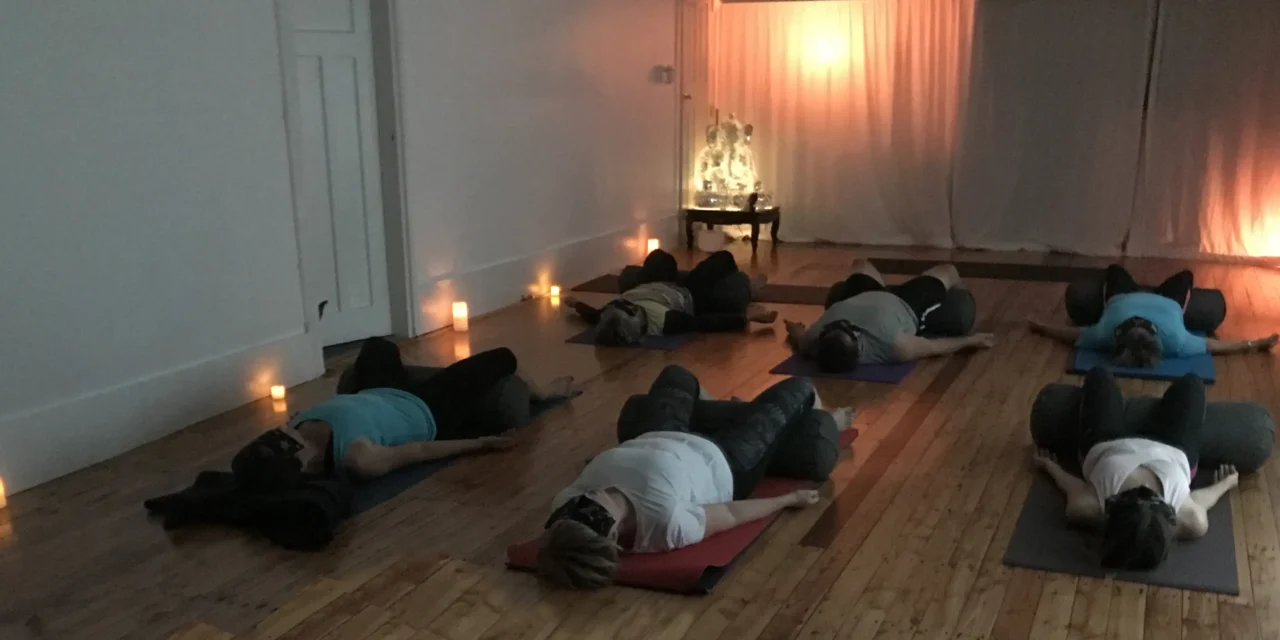In today’s fast-paced world, where stress seems almost unavoidable, many are turning to yoga as a form of exercise and a holistic approach to wellness. Beyond its physical benefits, yoga has been scientifically proven to significantly lower stress levels, reduce cortisol (the stress hormone) production, and even lower blood pressure. Let’s dive into the science behind how yoga achieves these remarkable effects.
Understanding Stress and Cortisol
Stress is a natural response to help us react quickly in challenging situations. However, chronic stress can lead to elevated levels of cortisol, which, over time, can contribute to a host of health problems, including high blood pressure, weight gain, and immune system suppression.
The Role of Yoga
Yoga, an ancient Indian practice influenced by the Hindu religion, means ‘to yoke’, to bring together. A non-dualistic philosophical outlook of not being separate from god, and in fact, god is within one’s self. ‘To yoke together’ is an attempt to bring all eight Limbs of Yoga to enlighten and reach samadhi. That’s not to say that is everyone’s end goal. Yoga, as we know it, brings many health benefits. The third branch of yoga is Asana, which is the physical postures and is what most people are exposed to.
The complete yoga practice starts with the gross (the most obvious work ) to the more subtle. Breathing techniques (Pranayama) is the fourth branch introduced in typical yoga can and can be utilized to control emotions and the nervous system. Dhyana ( meditation ) the seventh branch to harmonize the body and mind. The sequence of Asana and Pranayama is used to prepare for Dhyana/meditation. This multifaceted approach works synergistically to combat stress and its physiological effects.
Numerous studies have shown that practicing yoga can reduce cortisol levels in the body. A study published in the Journal of Clinical and Diagnostic Research found that regular yoga practice over a period of time significantly lowered cortisol levels in participants compared to non-yoga practitioners. This reduction not only helps in managing stress but also supports overall emotional well-being.
Interestingly, the type and duration of yoga practice appear to influence its impact on cortisol levels. A study in the International Journal of Yoga found that while gentle Hatha yoga and more vigorous Ashtanga yoga reduced cortisol levels, the latter showed a more significant decrease, possibly due to its higher intensity and meditative focus. Of course, this is subject to each practitioner’s experience.
Lowering Cortisol Levels
Yoga’s Biochemical Impact on Stress Extensive research has demonstrated yoga’s profound ability to modulate cortisol levels in the body, offering a biochemical explanation for its stress-reducing effects. Cortisol, often called the “stress hormone,” plays a crucial role in the body’s stress response system. While essential for survival, chronically elevated cortisol levels can lead to numerous health issues, including anxiety, depression, cardiovascular disease, and impaired immune function.
A study in the Journal of Clinical and Diagnostic Research revealed something fascinating about regular yoga practice: 12 weeks of consistent yoga significantly lowered participants’ cortisol levels compared to those who didn’t practice. The results were impressive – yoga practitioners showed nearly a 10% drop in their morning cortisol levels. This suggests that yoga helps reset our body’s main stress response system, the HPA axis.
The evidence doesn’t stop there. When researchers dug deeper and analyzed 42 different studies in the Journal of Psychiatric Research, they found a clear pattern: yoga consistently helps lower cortisol levels across all people. What’s particularly interesting is that people dealing with stress-related conditions saw the biggest benefits, making yoga a potent tool for those needing stress relief.
But yoga’s impact on our stress hormones goes even further. According to research published in Frontiers in Psychiatry, yoga helps get our daily cortisol rhythm back on track – that natural ebb and flow of stress hormones throughout the day. Think of it as helping your body’s internal clock run more smoothly, which is critical for everything from getting better sleep to keeping your metabolism humming along.
All these positive changes in cortisol levels set off a chain reaction of benefits throughout the body and mind. While the basis of yoga does apply healthy stress to reap the benefits, it helps keep crucial bad stress hormones in check. It’s not just about feeling less stressed—it’s about improving your overall emotional health, sharpening your thinking, and even boosting your immune system. It’s like hitting the reset button on your body’s stress response system, with benefits that ripple through your entire well-being. It is not unusual for clients to come to a yoga class for exercise but to stay for mindful regulation.
Stress Reduction through Mind-Body Connection
Yoga is a powerful practice for stress reduction because it fosters a deep connection between mind and body. At its core, yoga emphasizes mindfulness—the art of being fully present in the moment. This mindfulness extends beyond the yoga mat, empowering practitioners to navigate daily stressors with greater ease and composure.
Its fourth limb of Yoga, Pranayama ( life energy, breath control ), is central to yoga’s stress-reducing effects. These controlled breathing exercises activate the body’s relaxation response, effectively countering the fight-or-flight state often triggered by stress. For instance, the slow, deliberate breaths practiced in yoga stimulate the vagus nerve, a vital component of the parasympathetic nervous system for relaxation and recovery. Combined with meditation or a slower movement class like Yin, where the postures are mainly floor-based, consisting of long-held stretches, Yoga’s ability to reduce stress makes for non-negotiable practices for type A personalities.

Many yoga classes incorporate muscle relaxation techniques, such as myofascial balls and bolsters, to encourage relaxation and guided imagery/ meditation. These practices teach participants to systematically release tension throughout their bodies and visualize calming scenarios, further enhancing the stress-reduction benefits. Regular practitioners often report a heightened ability to recognize and release physical tension daily, demonstrating yoga’s lasting impact on stress management. Classes like Yoga Nidra help practitioners get into deep guided rest.
Balancing Blood Pressure Naturally
The relationship between chronic stress and high blood pressure (hypertension) is well-established, with prolonged stress being a significant risk factor for cardiovascular issues. Yoga’s multifaceted approach to stress reduction makes it a valuable tool in managing and potentially lowering blood pressure.
A review in the European Journal of Preventive Cardiology found that consistent yoga practice can significantly lower systolic and diastolic blood pressure, particularly in individuals with pre-existing hypertension, indicating its potential as a complementary therapy to traditional treatments. Yoga enhances blood pressure regulation through physical postures that improve circulation and flexibility, deep breathing techniques that balance the autonomic nervous system, and meditative practices that reduce stress, promoting better overall blood pressure health.
For some individuals with mild hypertension, regular yoga practice might serve as a natural alternative to medication. However, consulting with healthcare providers before changing prescribed treatments is advised.
Cultivating Holistic Well-being
Yoga’s true power lies in its holistic approach to overall health. Coupled with its sister modality, Ayurveda, it is a manual for life that seamlessly integrates physical, mental, and emotional well-being. Unlike many forms of exercise that focus primarily on physical fitness, yoga nurtures a profound mind-body self-awareness that extends far beyond the practice session.
Yoga physically enhances flexibility, strength, stability, and balance. These improvements often translate to better posture, reduced chronic pain, strength, better breathing, and increased body proprioception ( keeping balance and not falling over). The meditative aspects of yoga, including mindfulness and breath awareness, cultivate mental clarity and emotional resilience. Regular practitioners often report improved focus, reduced anxiety, and a greater sense of inner calm. This mental training helps individuals approach life’s challenges with a more balanced perspective, leading to better stress management and overall life satisfaction.

Practical Tips for Incorporating Yoga into Daily Life
If you’re new to yoga or looking to deepen your practice, consider these tips:
Start Slowly: If possible, begin with beginner-friendly classes rather than online tutorials. The benefit of a brick-and-mortar class is the communal energy in the room. Everyone is there for the same purpose. Going alone? It not unusual to make friends after a while. The Yoga community is a friendly, inclusive space.
Practice Regularly: Aim for at least 2-3 weekly sessions to experience the cumulative benefits. For mental health benefits, try practicing every day, including some gentler classes in your routine.
Listen to Your Body: Apply and try moderate stress, finding your edge and honoring your body’s limits with Ahimsa (not harming).
Explore Different Styles: From gentle restorative/ yin yoga to dynamic vinyasa, find a style that resonates with your needs by alternating strong classes with more nurturing ones.
Combine with Meditation: Enhance your practice by getting there earlier and/or staying longer to incorporate meditation for greater results.
Moreover, yoga philosophy encourages self-reflection and personal growth. Many practitioners find that the principles learned on the mat—such as nonjudgment, patience, acceptance, and emotional management—naturally flow off the mat and integrate into their daily lives, fostering better relationships and a more positive outlook. The synergy between physical postures, breathwork, and meditation in yoga creates a comprehensive approach to health that addresses the interconnectedness of body, mind, and spirit. Whether in a class or a few postures at home, this holistic perspective on well-being sets yoga apart as a practice that improves physical health and enhances overall quality of life.

